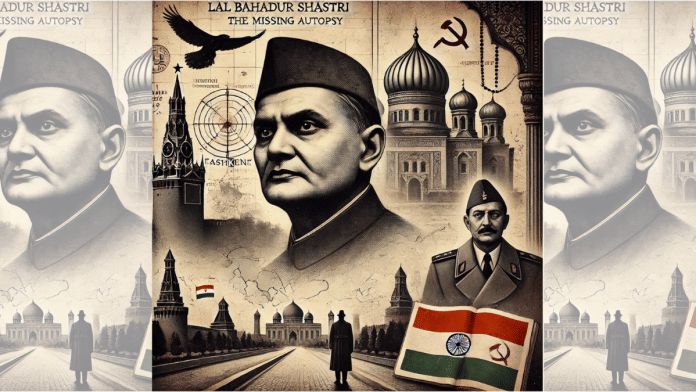Thank you dear subscribers, we are overwhelmed with your response.
Your Turn is a unique section from ThePrint featuring points of view from its subscribers. If you are a subscriber, have a point of view, please send it to us. If not, do subscribe here: https://theprint.in/
The sudden and enigmatic death of Lal Bahadur Shastri in Tashkent, hours after signing the Tashkent Agreement in 1966, has long raised questions about foul play and its impact on India’s geopolitical trajectory. Shastri’s passing occurred at a critical juncture when the Cold War’s shadow loomed large over India. While the official narrative attributed his death to a heart attack, emerging evidence and testimonies suggest a far more sinister story involving Soviet intrigue, false flag operations, and the consolidation of pro-Soviet leadership within India. Connecting these dots reveals a calculated shift in India’s foreign policy and political leadership, orchestrated to align the country with Soviet interests at the expense of its autonomy.
The Strategic Context: From Pro-US to Pro-Soviet
Lal Bahadur Shastri’s tenure as Prime Minister was characterized by a careful balance in foreign policy, reflecting India’s commitment to non-alignment. However, this position was under constant pressure during the Cold War. Shastri’s predecessor, Jawaharlal Nehru, had leaned toward the Soviet bloc, but under Shastri, there were clear signs of a potential pivot. This shift was particularly evident in India’s relations with the United States following the 1962 Sino-Indian War. President John F. Kennedy’s decisive support, including arms aid to India during the conflict with China, fostered goodwill and laid the foundation for a closer India-US partnership.
The Soviets, wary of India’s warming ties with the US, saw Shastri as a potential obstacle to their ambitions. His independent stance, combined with his growing popularity post the 1965 India-Pakistan War, posed a threat to Soviet influence. Thus, eliminating Shastri and installing a pro-Soviet leader became a strategic imperative.
The Night of Shastri’s Death: A Chilling Conspiracy
Shastri’s death on January 11, 1966, in Tashkent, remains shrouded in mystery. Officially declared a heart attack, eyewitness accounts and statements from his family painted a different picture. His personal physician, Dr. R.N. Chugh, reportedly observed unusual symptoms, including bluish discoloration on Shastri’s body, suggesting poisoning. Yet no autopsy was conducted, and critical medical records vanished.
Dr. Chugh’s role as a potential whistleblower was silenced when he himself died under mysterious circumstances in a road accident years later. The pattern of convenient deaths surrounding key witnesses further bolsters the theory of a coordinated cover-up, likely orchestrated by those with vested interests in maintaining the status quo.
The Rise of a Pro-Soviet Regime: Indira Gandhi’s Ascent
Following Shastri’s death, Indira Gandhi, daughter of Jawaharlal Nehru, ascended to power. Her rise marked a decisive shift in India’s foreign policy toward the Soviet Union. Unlike Shastri, who maintained an independent stance, Indira Gandhi’s tenure saw India move closer to Moscow, culminating in the 1971 Indo-Soviet Treaty of Peace, Friendship, and Cooperation. This alignment was not coincidental but part of a broader Soviet strategy to secure India as a key ally in South Asia.
Indira Gandhi’s pro-Soviet tilt was facilitated by an extensive network of Communist sympathizers and KGB operatives embedded in Indian politics and media. As documented in Mitrokhin Archive II: The KGB and the World, the Soviet Union invested heavily in influencing Indian policymakers and public opinion. Indira Gandhi’s leadership ensured the continuation of this narrative, solidifying Soviet influence in India’s strategic decision-making.
The Role of False Flag Operations
The Soviets were masters of disinformation and false flag operations. By orchestrating Shastri’s death and framing the CIA, the Soviets aimed to discredit the US and turn Indian public opinion decisively against it. Such tactics aligned with the KGB’s modus operandi, as revealed in declassified intelligence records. This narrative not only justified closer ties with the USSR but also marginalized voices advocating for a balanced foreign policy.
Why the Investigation Must Be Reopened
Reopening the investigation into Shastri’s death is not just a matter of historical justice but a critical step toward uncovering the truth about one of India’s most pivotal moments. The following factors underscore the need for a comprehensive inquiry:
- Geopolitical Implications: Understanding the role of Soviet interference and its impact on India’s foreign policy is essential for future strategic decision-making.
- Transparency and Accountability: Resolving unanswered questions about Shastri’s death would restore public trust in democratic institutions and the rule of law.
- Justice for Whistleblowers: The deaths of Dr. Chugh and other witnesses must be investigated to ensure accountability for those who sought to silence the truth.
Conclusion
Lal Bahadur Shastri’s death and its aftermath represent a critical juncture in India’s history, where external manipulation and internal power struggles shaped the nation’s future. The evidence of Soviet involvement, coupled with the rise of a pro-Soviet regime under Indira Gandhi, underscores the need for a thorough investigation. Uncovering the truth about Shastri’s death would not only honor his legacy but also provide valuable lessons for safeguarding India’s sovereignty and democratic integrity in an increasingly complex global landscape.
Akshay Sharma is a media and tech consultant with extensive experience working with regulatory bodies like Ofcom, FAA, ERNET, C-DOT, FCC, and CRTC. Formerly the CTO of one of the world’s first Video/WiFi smartphones and a Value Stream Management CTO for Governance Platforms, with clients like the World Bank, Akshay also serves as a board member for Somy Ali’s NGO, No More Tears. There, he collaborates on initiatives to combat domestic violence and human trafficking. He is also a Tech Advisory Board Member for Accure.AI in the AI/ML space. His perspectives are personal.
These pieces are being published as they have been received – they have not been edited/fact-checked by ThePrint.


